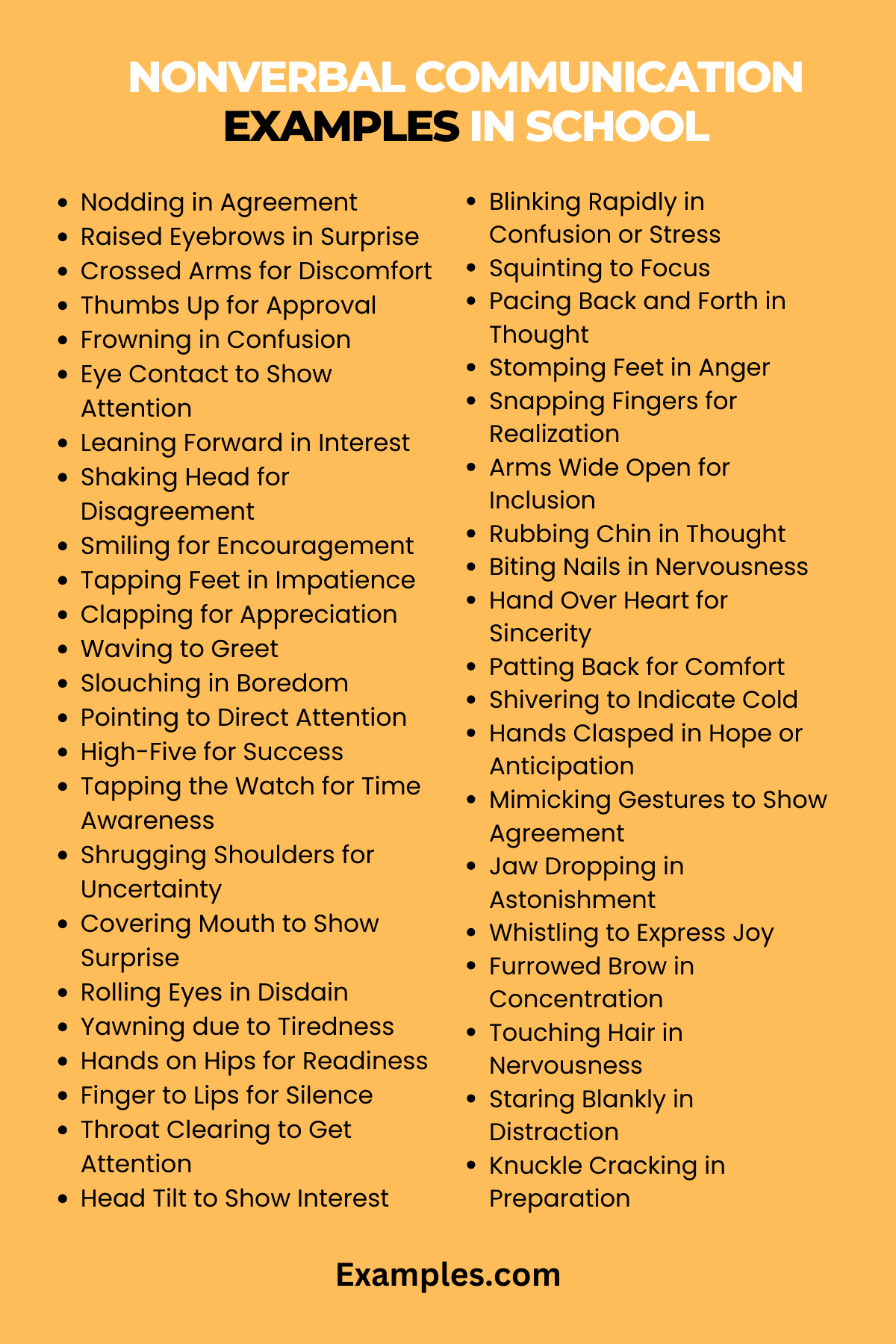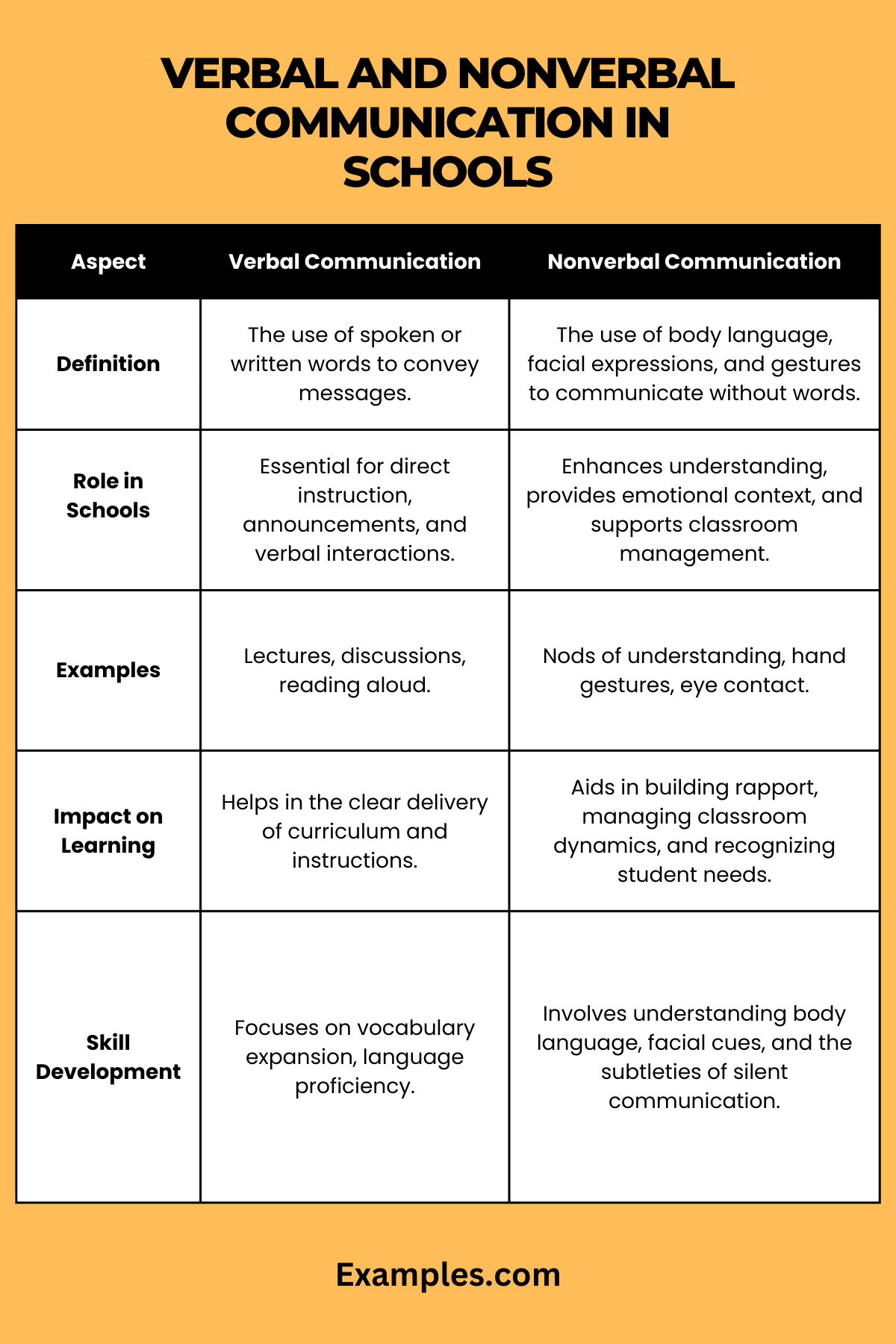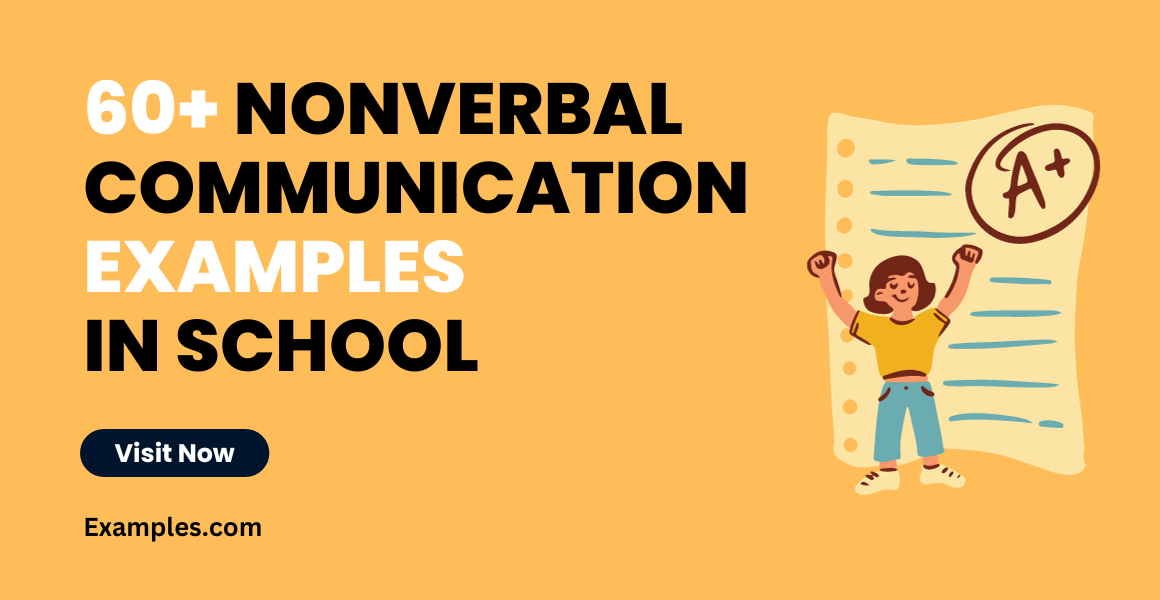49+ Nonverbal Communication in School Examples
Understanding Nonverbal Communication in School is pivotal for educators, students, and administrators alike. This complete guide delves into the subtleties of nonverbal cues, providing a wealth of nonverbal communication examples to illustrate their impact in educational settings. From gestures and facial expressions to posture and proximity, this guide offers insightful analysis and practical applications, enhancing interactions and creating a more empathetic, engaged, and effective learning environment. Discover the unspoken language of the classroom with this essential resource.
What is Nonverbal Communication in School? – Definition
Nonverbal communication in school refers to the ways students and teachers convey messages without using words. This includes body language, facial expressions, gestures, and even the way people use space. It’s a silent but powerful form of communication that complements spoken words, helping to express emotions and attitudes. In schools, nonverbal cues play a crucial role in classrooms, hallways, and during school activities, shaping the learning environment and influencing interactions among students and staff.
50 Nonverbal Communication Examples in School
Nonverbal communication in schools plays a pivotal role in shaping the educational experience. It encompasses a wide range of cues, from facial expressions to body language, that convey messages without words. These silent signals greatly impact how students and teachers interact and understand each other. This guide provides 50 unique examples of nonverbal communication in school settings, each with a brief explanation and example sentences, highlighting how these cues can be effectively used in educational environments.1. Nodding in Agreement: When a student nods while listening, it indicates understanding or agreement.

1. Nodding in Agreement: When a student nods while listening, it indicates understanding or agreement.
Example: When the teacher explains a concept, students nod to show they comprehend.
2. Raised Eyebrows in Surprise: This expression shows shock or disbelief.
Example: A student raises eyebrows when a surprising fact is shared in class.
3. Crossed Arms for Discomfort: Indicates defensiveness or discomfort.
Example: A student crosses arms when feeling challenged or uneasy during a discussion.
4. Thumbs Up for Approval: A universal sign of approval or agreement.
Example: A teacher gives a thumbs up to acknowledge a correct answer.
5. Frowning in Confusion: Suggests misunderstanding or need for clarification.
Example: A student frowns, signaling the teacher to re-explain a point.
6. Eye Contact to Show Attention: Maintaining eye contact signifies focus and interest.
Example: Students make eye contact with the teacher to show they are paying attention.
7. Leaning Forward in Interest: Indicates engagement or curiosity.
Example: A student leans forward eagerly during an intriguing lecture.
8. Shaking Head for Disagreement: Signifies disagreement or denial.
Example: A student shakes their head when they disagree with a point.
9. Smiling for Encouragement: A smile can be reassuring and supportive.
Example: Teachers smile at students to boost their confidence.
10. Tapping Feet in Impatience: Suggests restlessness or eagerness.
Example: A student taps their feet waiting for their turn to speak.
11. Clapping for Appreciation: Expresses approval or praise.
Example: Students clap after a classmate’s presentation to show their appreciation.
12. Waving to Greet: A friendly gesture to say hello or goodbye.
Example: A teacher waves to students as they enter or leave the classroom.
13. Slouching in Boredom: Indicates disinterest or boredom.
Example: A student slouches in their chair during a less engaging lesson.
14. Pointing to Direct Attention: Used to focus someone’s attention on something specific.
Example: The teacher points to a map while explaining geography.
15. High-Five for Success: A celebratory gesture for achievements.
Example: Students give each other high-fives after successfully completing a group project.
16. Tapping the Watch for Time Awareness: Indicates the importance of time or a reminder of a deadline.
Example: A teacher taps their watch, reminding students of the impending end of the exam.
17. Shrugging Shoulders for Uncertainty: Shows lack of knowledge or indecisiveness.
Example: A student shrugs when asked a question they are unsure about.
18. Covering Mouth to Show Surprise: Indicates shock or disbelief.
Example: Students cover their mouths in surprise during a dramatic revelation in a story.
19. Rolling Eyes in Disdain: Expresses annoyance or frustration.
Example: A student rolls their eyes when they disagree with a peer’s opinion.
20. Yawning due to Tiredness: Shows fatigue or boredom.
Example: Students yawn during an early morning or lengthy class.
21. Hands on Hips for Readiness: Indicates readiness or assertiveness.
Example: A teacher stands with hands on hips while giving instructions, showing authority.
22. Finger to Lips for Silence: A sign to be quiet or attentive.
Example: The librarian puts a finger to her lips to signal the need for quiet.
23. Throat Clearing to Get Attention: Used to signal that one wants to speak.
Example: A student clears their throat before answering a question in class.
24. Head Tilt to Show Interest: Indicates curiosity or empathy.
Example: A teacher tilts their head while listening to a student’s question, showing interest.
25. Winking to Indicate a Joke: Suggests playfulness or a shared secret.
Example: A teacher winks at the class after making a light-hearted joke.
26. Blinking Rapidly in Confusion or Stress: Indicates stress or confusion.
Example: A student blinks rapidly when struggling to understand a complex problem.
27. Squinting to Focus: Shows concentration or an attempt to understand better.
Example: Students squint while looking at fine details on a science model.
28. Pacing Back and Forth in Thought: Indicates deep thought or nervousness.
Example: A teacher paces back and forth while thinking about how to answer a complex question.
29. Stomping Feet in Anger: Expresses frustration or anger.
Example: A student stomps their feet in frustration during a challenging task.
30. Snapping Fingers for Realization: Signifies a moment of realization or remembrance.
Example: A student snaps their fingers when they recall an answer to a question.
31. Arms Wide Open for Inclusion: Indicates welcoming or acceptance.
Example: A teacher opens their arms wide to invite students to participate in a group activity.
32. Rubbing Chin in Thought: Shows deep thinking or pondering.
Example: A student rubs their chin while considering an answer to a difficult question.
33. Biting Nails in Nervousness: Indicates anxiety or nervous anticipation.
Example: A student bites their nails while waiting for test results.
34. Hand Over Heart for Sincerity: Demonstrates honesty or sincerity.
Example: A teacher places a hand over their heart while making a sincere promise to the class.
35. Patting Back for Comfort: A comforting gesture to show support.
Example: A student pats a classmate’s back to comfort them after a setback.
36. Shivering to Indicate Cold: Shows that one is feeling cold.
Example: Students shiver during a fire drill on a chilly day.
37. Hands Clasped in Hope or Anticipation: Signifies hope or expectation.
Example: A student clasps their hands together in hope before a major announcement.
38. Mimicking Gestures to Show Agreement: Indicates agreement or mimicry.
Example: Students mimic the teacher’s gesture of excitement about a field trip.
39. Jaw Dropping in Astonishment: Expresses extreme surprise.
Example: Students’ jaws drop in astonishment during a captivating science experiment.
40. Whistling to Express Joy: Indicates happiness or light-heartedness.
Example: A student whistles a tune while working on an enjoyable art project.
41. Furrowed Brow in Concentration: Shows deep focus or concern.
Example: A teacher furrows their brow while grading complex essays.
42. Touching Hair in Nervousness: Indicates anxiety or self-consciousness.
Example: A student touches their hair repeatedly while speaking in front of the class.
43. Staring Blankly in Distraction: Shows a lack of focus or daydreaming.
Example: A student stares blankly out the window, lost in thought during class.
44. Knuckle Cracking in Preparation: Indicates getting ready or relieving tension.
Example: A student cracks their knuckles before starting a difficult exam.
45. Wiping Sweat in Exertion: Shows effort or nervousness.
Example: A student wipes sweat from their brow while working hard on a physical education activity.
46. Hugging for Comfort or Congratulations: Expresses affection or congratulations.
Example: Students hug each other after winning a team competition.
47. Tugging Ear in Uncertainty: Indicates doubt or a need for reassurance.
Example: A student tugs their ear while unsure about an answer.
48. Drumming Fingers in Impatience: Expresses impatience or waiting.
Example: A student drums their fingers on the desk while waiting for the class to start.
49. Fist Pump in Triumph: Shows success or victory.
Example: A teacher does a fist pump when the class achieves a collective goal.
50. Bowed Head in Respect or Shame: Indicates respect or embarrassment.
Example: A student bows their head in respect during a solemn school ceremony.
Tips to Improve Nonverbal Interactions in the School
Enhancing nonverbal communication in schools is key to fostering a positive and effective learning environment. Our guide focuses on practical tips and unique examples, helping educators and students alike to refine their nonverbal interaction skills. By understanding and utilizing these silent cues, the school community can achieve better understanding, empathy, and cooperation.
1. Utilizing Mirroring Techniques: Mirroring the body language of others can build rapport and understanding.
Example: When a student leans forward, the teacher mirrors this posture to show engagement.
Tips: Start by subtly mimicking the body language of students during conversations. This can create a sense of connection and make them feel more understood.
2. Encouraging Expressive Gestures: Using hand gestures can enhance communication and clarity.
Example: A teacher uses open hand gestures while explaining a new concept to make the explanation more dynamic and understandable.
Tips: Incorporate diverse hand gestures in classroom discussions to emphasize points and keep students engaged.
3. Implementing Proximity Awareness: Being mindful of personal space can impact comfort levels.
Example: A teacher maintains an appropriate distance while interacting with students to ensure they feel comfortable.
Tips: Observe and respect personal space boundaries. Adjust your proximity based on the comfort level of the students.
4. Recognizing Facial Expressions: Understanding and responding to students’ facial expressions can provide insights into their feelings.
Example: A teacher notices a student’s confused expression and pauses to clarify the lesson.
Tips: Pay close attention to students’ facial expressions as a barometer of their understanding and emotions, adjusting your approach accordingly.
5. Emphasizing Eye Contact: Proper eye contact can convey attention and respect.
Example: During a one-on-one meeting, a teacher maintains eye contact to show they are fully attentive to the student’s concerns.
Tips: Practice balanced eye contact during interactions; too little may seem disinterested, while too much might be intimidating.
6. Developing a Welcoming Posture: An open posture invites interaction and shows approachability.
Example: A counselor maintains an open, relaxed posture while talking to students, making them feel more at ease to express themselves.
Tips: Avoid crossing arms or legs which can seem closed off; instead, adopt an open posture to appear more welcoming.
7. Utilizing Nodding to Show Understanding: Nodding at appropriate times shows that you are listening and understand.
Example: A teacher nods periodically while a student explains their project, indicating their attentiveness.
Tips: Use nodding to show you are following along, especially when students share ideas or ask questions.
8. Being Mindful of Cultural Differences in Nonverbal Communication: Different cultures may interpret nonverbal cues differently.
Example: A teacher learns about various cultural interpretations of gestures to avoid misunderstandings with students from diverse backgrounds.
Tips: Educate yourself about the nonverbal communication norms of different cultures represented in your classroom.
9. Encouraging Nonverbal Feedback Mechanisms: Use nonverbal cues as a feedback tool.
Example: Teachers use thumbs-up or thumbs-down gestures to quickly gauge student understanding of a topic.
Tips: Implement simple nonverbal signals in the classroom for quick and efficient feedback from students.
10. Using Timing and Pace Effectively: The timing and pace of your movements and speech can impact communication.
Example: A teacher deliberately slows down their speech and movements when explaining complex subjects to aid understanding.
Tips: Be mindful of your speech pace and body movements, especially when discussing new or challenging topics.
Verbal and Nonverbal Communication in Schools
In the dynamic environment of schools, communication extends far beyond spoken words. The interplay between verbal and nonverbal communication forms the backbone of effective teaching, learning, and interaction. This section explores how these two forms of communication coexist and complement each other in educational settings. While verbal communication is the cornerstone of imparting knowledge and instructions, nonverbal communication adds depth and emotion to these interactions. By understanding and balancing both, educators and students can foster a more nuanced and empathetic educational experience.

| Aspect | Verbal Communication | Nonverbal Communication |
|---|---|---|
| Definition | The use of spoken or written words to convey messages. | The use of body language, facial expressions, and gestures to communicate without words. |
| Role in Schools | Essential for direct instruction, announcements, and verbal interactions. | Enhances understanding, provides emotional context, and supports classroom management. |
| Examples | Lectures, discussions, reading aloud. | Nods of understanding, hand gestures, eye contact. |
| Impact on Learning | Helps in the clear delivery of curriculum and instructions. | Aids in building rapport, managing classroom dynamics, and recognizing student needs. |
| Skill Development | Focuses on vocabulary expansion, language proficiency. | Involves understanding body language, facial cues, and the subtleties of silent communication. |
What are the Types of Nonverbal Communication in the Classroom?
The classroom is a vibrant hub of nonverbal cues, each type contributing uniquely to the educational process. This section delves into the diverse types of nonverbal communication that are prevalent in classrooms. From facial expressions that reveal unspoken emotions to gestures that can accentuate a point or convey understanding, each form plays a crucial role in enhancing the learning experience. Recognizing and interpreting these nonverbal signals are vital skills for both teachers and students, aiding in creating a more engaging and responsive learning environment.
- Facial Expressions: Facial cues are powerful indicators of emotions and reactions. A teacher’s smile can encourage a student, while a frown can indicate disapproval or concern.
- Gestures: Hand movements and gestures can emphasize points in a lesson, indicate the need for attention, or offer guidance without interrupting verbal communication.
- Posture and Body Orientation: The way teachers and students position their bodies can show engagement, openness, or resistance. For example, leaning forward can suggest interest, while crossed arms might indicate disengagement.
- Eye Contact: Eye contact is essential for engagement and connection. It can be used to gain attention, show interest, or offer nonverbal feedback.
- Proxemics (Use of Space): The physical distance between people in a classroom affects communication. Close proximity can foster intimacy and engagement, while too much distance can create a sense of detachment.
- Haptics (Touch): In appropriate situations, touch can be a powerful tool for comfort and encouragement, such as a pat on the back for a job well done.
- Paralanguage (Tone of Voice, Pauses): Even in silent moments or during speech, the tone, pitch, and pauses play a significant role in conveying messages.
- Appearance and Artifacts: Teachers’ and students’ appearance, along with classroom decorations, can communicate standards, expectations, and the educational climate.
Understanding these types of nonverbal communication is vital for creating a positive and effective learning environment.
How to Teach Nonverbal Communication in Schools
Teaching nonverbal communication is as essential as teaching verbal communication in schools. This section provides insights into methods and strategies for effectively incorporating nonverbal communication into the educational framework. It highlights the importance of teachers not only using nonverbal cues effectively but also teaching students to recognize and interpret these cues. This skill set is crucial for students, as it enhances their understanding of social interactions and emotional intelligence. The section offers practical tips on how educators can model and teach these invaluable skills in the classroom, thus preparing students for more effective communication both inside and outside the school environment.
- Integrate into Curriculum: Include lessons on nonverbal communication as part of the curriculum. Use role-playing activities to demonstrate different types of nonverbal cues.
- Modeling: Teachers should model effective nonverbal communication. Demonstrating appropriate facial expressions, gestures, and body language can serve as a practical guide for students.
- Observation and Discussion: Encourage students to observe and discuss nonverbal communication in various settings, like in videos, during presentations, or in peer interactions.
- Feedback and Reflection: Provide students with feedback on their nonverbal skills and encourage self-reflection. Discuss how their nonverbal communication affects others.
- Cultural Sensitivity: Teach students about the cultural variations in nonverbal communication to promote understanding and inclusivity.
- Use of Technology: Incorporate multimedia resources, like videos and interactive games, to teach and demonstrate nonverbal communication effectively.
- Classroom Activities: Organize activities that focus specifically on nonverbal cues, such as charades or silent storytelling, to enhance students’ understanding and usage of nonverbal communication.
By implementing these strategies, schools can equip students with the necessary skills to interpret and use nonverbal communication effectively, enhancing both their academic and social experiences.
In conclusion, understanding and utilizing nonverbal communication in schools is pivotal for enhancing the educational experience. This guide has illuminated various examples and provided actionable tips to improve nonverbal interactions. By embracing these insights, educators and students can foster a more empathetic and effective learning environment, where silent cues speak volumes, enriching the tapestry of school communication.



